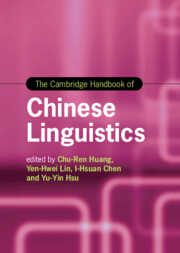Book contents
- The Cambridge Handbook of Chinese Linguistics
- Cambridge Handbooks In Language and Linguistics
- The Cambridge Handbook of Chinese Linguistics
- Copyright page
- Contents
- Figures
- Tables
- Contributors
- Acknowledgments
- Part One Writing System/Neuro-cognitive Processing of Chinese
- Part Two Morpho-lexical Issues in Chinese
- 3 Wordhood and Disyllabicity in Chinese
- 4 Characters as Basic Lexical Units and Monosyllabicity in Chinese
- 5 Parts of Speech in Chinese and How to Identify Them
- 6 Gaps in Parts of Speech in Chinese and Why?
- 7 Derivational and Inflectional Affixes in Chinese and Their Morphosyntactic Properties
- 8 The Extreme Poverty of Affixation in Chinese
- 9 On an Integral Theory of Word Formation in Chinese and Beyond
- 10 Compounding Is Semantics-driven in Chinese
- Part Three Phonetic-phonological Issues in Chinese
- Part Four Syntax-semantics, Pragmatics, and Discourse Issues
- Index
- References
7 - Derivational and Inflectional Affixes in Chinese and Their Morphosyntactic Properties
from Part Two - Morpho-lexical Issues in Chinese
Published online by Cambridge University Press: 04 August 2022
- The Cambridge Handbook of Chinese Linguistics
- Cambridge Handbooks In Language and Linguistics
- The Cambridge Handbook of Chinese Linguistics
- Copyright page
- Contents
- Figures
- Tables
- Contributors
- Acknowledgments
- Part One Writing System/Neuro-cognitive Processing of Chinese
- Part Two Morpho-lexical Issues in Chinese
- 3 Wordhood and Disyllabicity in Chinese
- 4 Characters as Basic Lexical Units and Monosyllabicity in Chinese
- 5 Parts of Speech in Chinese and How to Identify Them
- 6 Gaps in Parts of Speech in Chinese and Why?
- 7 Derivational and Inflectional Affixes in Chinese and Their Morphosyntactic Properties
- 8 The Extreme Poverty of Affixation in Chinese
- 9 On an Integral Theory of Word Formation in Chinese and Beyond
- 10 Compounding Is Semantics-driven in Chinese
- Part Three Phonetic-phonological Issues in Chinese
- Part Four Syntax-semantics, Pragmatics, and Discourse Issues
- Index
- References
Summary
The concepts being discussed in this chapter are bound morpheme, free morpheme, root, affix, semi-affix, inflection, derivation and their application in the analysis of Chinese word-formation process. The inflectional affixes include aspectual markers, plural marker, potential infixes as well as those involved in reduplication. Two major approached are presented in this chapter about the derivation of Chinese words. The essence of the morphological derivation approach is that most word-building blocks have equal status as free root and bound roots, except for affixes. Chinese words are formed with these roots according to morphological rules and the syntactic status of a word is determined by its head. The essence of the syntactic-semantic is that the majority of Chinese words are constructed according to syntactic rules in that the relationship between morphemes in a word could be described as conjunction, modification, subject-predicate, verb-object or verb-result. A few bound morphemes are treated as affixes since their semantic content has been bleached, and they form words with morphological rules.
- Type
- Chapter
- Information
- The Cambridge Handbook of Chinese Linguistics , pp. 135 - 157Publisher: Cambridge University PressPrint publication year: 2022

